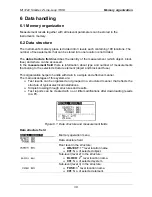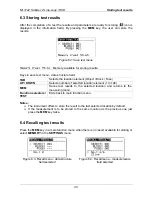
MI 3122 Smartec Z Line-Loop / RCD
Testing RCD
25
Connections for testing RCD
L1
L2
L3
N
PE
R
E
Ro
L
PE
N
L/L
1
N/L2
PE/L3
Figure 5.2: Connecting the plug commander and the universal test cable
5.1.1 Contact voltage (RCD Uc)
A current flowing into the PE terminal causes a voltage drop on earth resistance, i.e.
voltage difference between PE equipotential bonding circuit and earth. This voltage
difference is called contact voltage and is present on all accessible conductive parts
connected to the PE. It shall always be lower than the conventional safety limit voltage.
The contact voltage is measured with a test current lower than ½ I
N
to avoid trip-out of the
RCD and then normalized to the rated I
N
.
Contact voltage measurement procedure
Select the
RCD
function using the function selector switch.
Set sub-function
Uc.
Set test
parameters
(if necessary).
Connect
test cable to the top of the instrument.
Connect
test leads to the item to be tested (see
figure 5.2
).
Press the
TEST
key to perform the measurement.
Store
the result by pressing the MEM key (optional).
The contact voltage result relates to the rated nominal residual current of the RCD and is
multiplied by an appropriate factor (depending on RCD type and type of test current). The
1.05 factor is applied to avoid negative tolerance of result. See table 5.1 for detailed
contact voltage calculation factors.
RCD type
Contact voltage Uc
proportional to
Rated I
N
AC G
1.05
I
N
any
AC
S
2
1.05
I
N
A G
1.4
1.05
I
N
30 mA
A
S
2
1.4
1.05
I
N
A G
2
1.05
I
N
< 30 mA
A
S
2
2
1.05
I
N
Table 5.1: Relationship between Uc and I
N






























